Narberth is a busy market town, just off the main A40 from Carmarthen to Haverfordwest, inside the Pembrokeshire Border. The Town has a long history, and was mentioned in the Mabinogion. During both World Wars, many men from Narberth left for war, never to return. The War Memorial is situated at the top of Market Street, on the one way system that runs through the Town Centre.

The Great War, 1914-1918
Ernest Bowen, Private, 200043, Welsh Regiment. Ernest was the son of Mrs. Mary Bowen, of Church House, Robeston Wathen. He enlisted at Narberth into the 4th Battalion, Welsh Regiment. Duirng the summer of 1918, Ernest was posted to France, where he joined the 15th Battalion, Welsh Regiment. The battalion was known as the Carmarthen Pals battalion, and had been in France since December 1915 attached to 114 Brigade, 38th Welsh Division. Ernest joined the battalion on the Somme, where they held the line near Aveluy Wood. On 21 August 1918 the 15th Welsh crossed the flooded River Ancre, and launched an attack on the German positions at Thiepval and Pozieres Ridges. Their objectives were captured within days, and the entire Division then began their drive toward the Hindenburg Line. Ernest was killed in action during the Battle of Épehy, on 18 September 1918, aged 23. He had been attached to the 114th Trench Mortar Battery, and was at the forefront of the fighting when he was killed. He is buried at Gouzeaucourt New British Cemetery, France.

Reginald Burgess, Lieutenant, Royal Flying Corps. Reginald was born on 22 May 1892, the son of Walter and Edith Burgess, of Blaenmarlais, Narberth. Reginald was commissioned Second Lieutenant into the 15th Welsh on 4 January 1915. He transferred to the 38th Division Army Cyclist Corps on 15 May 1915 and moved to France on 3 December 1915. Reginald then volunteered for service with the Royal Flying Corps, and served as an Observer with 22 Squadron. On the opening day of the Somme Offensive, on 1 July 1916, Reginald was acting as Observer to Pilot Lieutenant J. H. Firstbrook, on a photo reconnaissance mission over Clery-Longueval, when their aeroplane, FE2b, Serial 6365, was shot down over the German lines. Both men were taken prisoner, but Reginald was badly wounded in the crash, dying as a result at the German Hospital at Fremicourt on 7 July 1916. He was 24 years old, and is buried at Douchy-Les-Ayette British Cemetery, France.
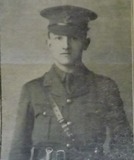

Edwin Osborne Davies, Private, 10611, Welsh Regiment. Edwin was the son of Alfred Davies and Lettice Maddox Phillips Davies, of Sessions Court, St. James’ St., Narberth, and had enlisted into the 2nd Battalion, the Welsh Regiment, which had been in France since the first action at Mons, with 3 Brigade, 1st Division. They fought from Mons in the rearguard action south toward the Marne where the German Offensive was stopped, and after pushing the Germans back to the Aisne, moved to Ypres, where they fought at First Ypres and Gheluveldt. Edwin was Killed in Action during the first winter at Ypres, on 3 January 1915, aged just 21. He is remembered on the Le Touret Memorial, Richebourg L’Avoue, France. His brother Frank also fell.

Frank Victor Davies, Private, 47247, Royal Welsh Fusiliers. Frank was the son of Alfred and Lettice Maddox Davies, of St. James Street, Narberth. He had enlisted at Goodwick into the 15th Battalion, Welsh Regiment, which was the Carmarthen Pals battalion, but later transferred into the 3rd Battalion Royal Welsh Fusiliers, which were a reserve Battalion based in the UK. This shows that Frank was wounded at some time, and returned home, being unfit for service on the front. He sadly died at Birkenhead on 19 September 1916, aged 17. Frank is buried at Narberth Cemetery. His brother Edwin also fell.

George Elwyn Davies, Private, 282284, Lancashire Fusiliers. George was the son of William and Elizabeth Davies, of Brynmor, Templeton. He had worked as a Butcher at Narberth prior to the war and enlisted at Narberth into the Pembroke Yeomanry. After completing his training George was posted to the 2/7th Battalion Lancashire Fusiliers, which was attached to 197 Brigade, 66th Division. The Battalion landed at Havre on 28 February 1917, moving to the Belgian coast, where a secret offensive, Operation Hush, had been planned. At the end of September it was moved south to reinforce the Allied troops assaulting the Passchendaele Ridge, during the Third Battle of Ypres. On 5 October the division relieved the 3rd Australian Division in the front line near Poelcappelle. The division attacked from their trenches following a heavy artillery bombardment on the morning of 9 October 1917, but found the German defences untouched by the artillery barrage. After heavy fighting elements of the division forces their way into Passchendaele village, but were later forced to retire. George was badly wounded at Passchendaele and brought back to the Casualty Clearing Station at Remy Sidings, where he sadly died of Wounds on 11 November 1917, aged just 22. He is buried there at Lijssenthoek Military Cemetery, Belgium. The photo of George is courtesy of Narberth Museum.

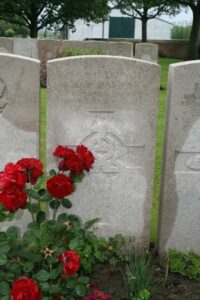
Arthur Stanley Dayson, Lance Corporal, 320871, Welsh Regiment. Arthur was born on 27 December 1883, the son of John and Mary Ann Dayson, of Blaendynfi, Port Talbot, Glam. Prior to the outbreak of war, he is shown as residing in Narberth, where he was manager of the Star Supply Tea Company. He enlisted at Bridgend into the Glamorgan Yeomanry, which had formed there at the outbreak of war, as part of the South Wales Mounted Brigade. In November 1915 the Brigade was dismounted, and embarked for Egypt, landing by March 1916 where they were absorbed into the 4th (Dismounted) Brigade. On 2 February 1917 the Glamorgan Yeomanry merged with the Pembroke Yeomanry to form the 24th Battalion, Welsh Regiment, and the Battalion joined 231 Brigade 74th (Yeomanry) Division. The Division took part in the advance into Palestine from March 1917, and fought in the Battles of Gaza, and the capture of Jerusalem. Arthur was wounded during the capture of Jerusalem, and sadly Died of Wounds at the 231st Field Ambulance on 2 December 1917, aged 32. He is buried in Jerusalem War Cemetery, Israel. Arthur is not commemorated at Narberth.


Benjamin Albert Evans, Private, 307167, Lancashire Fusiliers. Benjamin was born at Templeton in 1892, the son of Price and Elizabeth Evans. The family later resided at 40, Mackworth Street, Bridgend, Glamorgan. Benjamin had initially served with the 2/8th Battalion, Lancashire Fusiliers, which was attached to 197 Brigade, 66th (2nd East Lancs) Division, but does not appear to have served overseas with the battalion. At some time Benjamin had been medically downgraded, and was posted to the 533rd Agricultural Company, Labour Corps, with his service number changing to 67103. Benjamin died as on 7 February 1919, aged 26. He is buried at Molleston Baptist Chapelyard, Templeton.

Frederick Oliver Evans, Private, 350, Welsh Regiment. Frederick was born at Cardiff in 1892, the son of Thomas Rees Evans and Mary Ann Evans. His parents were from Narberth, and had moved back to Providence Hill, Narberth prior to 1901. Frederick enlisted at Cardiff into the 1/4th Battalion, Welsh Regiment, which was the Carmarthenshire Territorial Battalion. At the outbreak of war, the Battalion assembled at Carmarthen, as part of the South Wales Brigade. Frederick died at Penally on 17 February 1915, aged only 22, and is buried in Narberth Cemetery.

Tom Luther Evans, Private, 10539, Welsh Regiment. Tom was born at St. Clears in 1893, the son of William and Martha Evans. By 1901 the family had moved to Coxlake, Narberth. At some time prior to 1911, Tom enlisted at Llanelli into the 1st Battalion, Welsh Regiment, who were in India at the outbreak of war. The battalion returned to Britain, where it joined 84 Brigade, 28th Division. The Division was made up of regular army units that had been brought back to the UK at the outbreak of war, and landed at Marseilles on 18 January 1915, moving to the Ypres sector. Tom was wounded at Ypres, and Died of Wounds on 4 February 1915, aged 21. He is remembered on the Ypres Menin Gate Memorial, Belgium. His father William Evans also served and died after the armistice as a result of his service, but he is not commemorated on the memorial.

William Evans, Private, 51596, Royal Welsh Fusiliers. William was the son of Isaac and Mary Evans, of Cold-Blow. He worked as a Coachman and Gardener prior to the war, and resided with his wife, Martha Evans, at Plas Cottages, Church Street Narberth. There is not much information available on him, but he served in the 3rd Battalion, Royal Welsh Fusiliers. This was a Home Service Battalion that had began the war at Pembroke Dock. They moved to Headquarters at Wrexham on 9 August 1914, and moved to Litherland near Liverpool in May, 1915. The Battalion moved to Ireland to deal with the rebellion during August 1917 and remained there for the duration of the war, stationed at Limerick. William died at home on 26 April 1921, aged 52, and is buried at Narberth Cemetery. William is not commemorated at Narberth, but his son, Tom Luther Evans, is.

Arthur Irving, Driver, 5526, Royal Field Artillery. Arthur was the son of John and Mary Irving, of Church Street, Narberth. He worked as a labourer at a brickworks prior to the war, and enlisted at Haverfordwest into the Royal Field Artillery, where he served in their “C” Battery, 88th Brigade. The Brigade served with the 19th (Western) Division, and crossed to France during July 1915. The Division fought in most of the major actions of the war from here on. They fought during the Battle of Loos, and then moved south to the Somme, where they captured La Boisselle. They fought through most of the Somme Battles of 1916 before being moved to Ypres, where they fought at the Battle of Messines, which was the opening phase of Third Ypres, or Passchendaele, then at the Menin Road, Polygon Wood, Broodseinde, Poelcappelle and at Passchendaele Village itself. After terrible casualties, they moved to a ‘quieter’ area east of Bapaume, but were caught there during the opening of the German Spring Offensive of 21 March 1918 and were decimated during the ensuing Battles of St. Quentin and Bapaume. They were removed from the area, and moved north again to Ypres, where they again came under heavy attack, during the Battles of Messines, Bailleul and Kemmel. By now the Divisional casualties were severe, and they were moved south to the Aisne, in another ‘quiet’ sector, but they were again caught up in the action, during the Battle of the Aisne, where Arthur was wounded. He Died of Wounds on 5 June 1918, aged 32, and is buried at Marfaux British Cemetery, France. Arthur had been Mentioned in Despatches twice during the war, so was obviously a brave man.

Hector Wilmot James, Private, 1991, Monmouthshire Regiment. Hector was born in 1896, the son of William and Elizabeth James, of Myrtle Hill, Narberth. His father William died in 1900, and Elizabeth moved to family to Pengam by 1911. Hector enlisted at Aberbargoed into the 1st Battalion, Monmouthshire Regiment. The Battalion were formed in Newport in August 1914, as part of the Welsh Border Brigade, Welsh Division. In February, 1915 they moved to France, attached to 84 Brigade, 28th Division. They first saw action during Second Ypres, which is where Hector was Killed in Action on 8 May 1915, aged 19. His body was lost on the battlefield, and so he is remembered on the Ypres (Menin Gate) Memorial, Belgium. Hector is not commemorated locally.

Henry John, Private, 202910, South Lancashire Regiment. Henry was born near Clynderwen, the son of Thomas and Naomi John, of Brynhill. He enlisted at Nantwich into the army, and was posted to the 2/4th Battalion, South Lancashire Regiment, which formed part of 172 Brigade, 57th Division. The Battalion were in the trenches at Armentieres, in Northern France, in mid 1917, and it was here that Henry suffered serious wounds. He Died of Wounds on 7 June 1917, aged 32, and was buried in Longuenesse (St. Omer) Cemetery, France.


Evan Tom Jones, Private, 43634, Worcestershire Regiment. Evan was the son of David and Mary Jones, later of Llettyrwenol, Cwrtnewydd, Llanybyther. He enlisted at Narberth into the army, and was posted to the 2/8th Battalion, Worcestershire Regiment, which had landed in France on 28 May 1916, attached to 182 Brigade, 61st (2nd South Midland) Division. The Division saw their first major action during the diversionary attack on Fromelles on 19 July 1916. They suffered terrible casualties, for no gains, and were not used again until March 1917 when the Germans withdrew to the Hindenburg Line, and captured Chaulnes and Bapaume. In August 1917 the Division moved north and fought at the Battle of Langemarck, then fought at the Battle of Cambrai during November and December, 1917. They were caught up in the German Spring Offensive of March 1918 at the Battle of St. Quentin, and the Battle of Rosieres, where they defended the area around Ham, near St. Quentin, in the face of ferocious German onslaught. After suffering heavy casualties, the Division moved to Flanders, but were caught up in the German Offensive there, fighting at the Battles of Estaires, Hazebrouck and Bethune. During August 1918 the Germans were halted mainly due to an Australian Victory at Villers Brettoneux, and the tide turned in favour of the Allies. The Division took part in the Final Advance in Flanders, then pushed south, where Evan died on 5 October 1918, aged 19. He is buried in Leuze Communal Cemetery, France.

Harry Jones, Private, 10048, Duke of Cornwall’s Light Infantry. Harry was born at Narberth in 1894, the son of John and Henrietta Jones. Prior to the war the family had moved to 9, Cambridge Street, St. Thomas, Exeter. Harry enlisted at Exeter into the 1st Battalion, Duke of Cornwall’s Light Infantry prior to the war. At the outbreak of war, the Battalion was stationed at the Curragh, Ireland. They landed at Le Havre on 15 August 1914, as part of 14 Brigade, 5th Division, and were among the first British troops to see action in France, at the Battle of Mons, on 23 August 1914. They retreated south toward Le Cateau, where they put up a gallant stand which slowed the German advance, and then retreated towards the Marne, where the German Offensive was stopped dead. The BEF pushed the Germans back to the Aisne, and fought a battle here that was to help form the lines of the Western Front for the duration of the war. After the Battle of the Aisne the Division moved to Flanders, and fought at La Bassee, and then at Messines in 1914. They fought at First Ypres in 1914 and Second Ypres in 1915, and remained in Flanders for the remainder of the year. On 12 January 1916 the Battalion transferred to 95 Brigade but remained in the 5th Division, moving to a sector north of Arras, between St. Laurent Blangy and Vimy. They remained here until moving to the Somme, where they fought at High Wood, Guillemont Flers-Courcelette, Morval and Le Transloy, and left the Somme on 5 October 1916, moving to Festubert to rebuild. In March, 1917 the Division fought during the Battle of Vimy, which was the opening stage of the Arras Offensive, and they also fought at La Coulotte and the Scarpe, where they took Oppy Wood. Harry was Killed in Action at Oppy Wood on 19 July 1917, aged 22. He is buried at Roclincourt Military Cemetery, France. Harry is not commemorated locally.

Thomas Jones, Private, 1756, Welsh Guards. Thomas was the son of Stephen and Sarah Jones, of Merlin’s Bridge, Haverfordwest. He married Ada Augustus Bennett at Narberth on 14 October 1913, and they lived at Lower House, South Dairy, Clarbeston Road. The couple had two young girls. Thomas enlisted at Haverfordwest on 30 June 1915 into the 1st Battalion, Welsh Guards. The Welsh Guards was raised on 26 February 1915 by order of King George V, in order to complete the national complement of regiments of Foot Guards, and became part of 3 Guards Brigade, Guards Division. On 17 August 1915 the 1st Battalion sailed for France, and took up position in the line at Loos. They fought with great distinction at Loos through the remainder of the year, and in summer of 1916 moved to the Somme, where they fought at the Battle of Flers-Courcelette, and then at the Battle of Morval, capturing Lesboeufs Village. Thomas joined the Welsh Guards on the Somme on 31 August 1916. Sadly he was killed here on 26 September 1916, aged 26. He has no known grave, and is commemorated on the Thiepval Memorial, France.


Ronald Hastings Lascelles, DSO, MID, Lieutenant-Colonel, Royal Horse Artillery. Ronald was born in Narberth, the only son of Arthur Hastings Lascelles and Georgina Jane Murray Lascelles (nee Curtis) of North Cheriton, Templecombe, Somerset. He was educated at Cheltenham prior to being commissioned from the Royal Military Academy into the Royal Field Artillery on 25 June 1899, and had served in the South African War, being wounded at Senekal on 20 June 1900. At the outbreak of the Great War Ronald was serving with the Royal Horse Artillery, which had the purpose of providing light artillery support for the Cavalry Divisions on the Western Front. He served in France throughout the entire war, being mentioned in despatches several times, and was awarded the Distinguished Service Order, but died of pneumonia on 16 February 1919 aged 38. He is buried at Charlton Cemetery, Greenwich, in Grave Ref. 1. C. N. 15.
David James Lewis, Private, 5139, Welsh Regiment. David was the son of Thomas Lewis and Minnie Lewis (nee Davies). The family was from Narberth, but had resided for several years at Aberdare, before moving to 17, Waterloo Terrace, Pembroke Dock. David worked as a Porter for the GWR prior to the war, before becoming a signalman at Henllan Station. He enlisted at Carmarthen into the local Territorial Battalion, the 1/4th Battalion, Welsh Regiment, which was attached to 159 Brigade, 53rd (Welsh) Division. The Division moved to the Mediterranean, sailing from Devonport in July, 1915 arriving at Mudros by 5 August 1915. From here they moved to Gallipoli, landing on 9 August. Here the Division was immediately thrown into action, and spent the next few days in isolated pockets, fighting against a Turkish counter-attack during the Battle of Sari Bair, and then at the Attack on Scimitar Hill. David was killed here on 23 August 1915, aged 22. He is buried at Hill 10 Cemetery, Gallipoli, in Grave Ref. I. C. 13. The memorial shows his rank as Captain, but there is no man of that rank and name who fell during the war.

George Palmer Lewis, Private, 2020, Berkshire Yeomanry. George was born at Narberth, the son of John Richard Lewis and Mary M. Lewis, of Crinow Farm. He worked at Worcester as an Ironmonger prior to the war, and enlisted at Reading into the Berkshire Yeomanry. In August 1914 the Berkshire Yeomanry were stationed at Reading as part of the 2nd South Midland Mounted Brigade. In September they moved into the 2nd Mounted Division, and in April 1915 moved to Egypt, where they were dismounted and sent to Gallipoli. George was Killed in Action at Gallipoli on 28 May 1915, aged 30, and is remembered on the Helles Memorial, Gallipoli.
William Albert Lewis, Private, M/286086, Royal Army Service Corps. William was born at Landshipping in 1884, the son of George and Margaret Lewis. He married Mary Ann Lewis at Narberth on 10 April 1909, and the couple resided at Church Street, Narberth, where they raised two children. He was a Motor Driver prior to the war. William enlisted on 10 December 1915 into the Motor Transport arm of the Army Service Corps. William served as a Driver with the Army Service Corps for over two years, until being hospitalised at Devonport for several weeks. William was discharged as medically unfit on 9 August 1918, suffering from malaria. He died at home on 17 March 1920, aged 35, and is buried at Narberth Cemetery.

William John Lewis, Sapper, 108017, Royal Engineers. William was born at Llawhaden in 1894, the son of John and Mary Anne Lewis. His parents later resided at Blaencilgoed, Ludchurch. William enlisted at Haverfordwest into the Royal Engineers. William was posted to their 123rd Field Company, which was attached to the 38th (Welsh) Division. The Division had arrived in France during December 1915 and had moved to the sector near Armentieres. They were to remain here until June 1916 when they were sent to the Somme, where they famously captured Mametz Wood. The battered division had then moved via Hebuterne, to positions at Boesinghe, north of Ypres. It was here that William was Killed in Action, on 18 June 1917, aged 23. He is buried in Bard Cottage Cemetery, Belgium.

George David Llewellyn, Private, 38605, Royal Welsh Fusiliers. George was born in 1876, the son of John and Emma Llewellyn, of Sheep Street, Narberth. He enlisted at Llanelli on 28 November 1914 into the 15th Battalion, Welsh Regiment, which was to become known as the Carmarthen Pals Battalion, and was attached to the 38th (Welsh) Division. When the battalion moved to France in December 1915, George remained at Kinmel Park, attached to the 21st Welsh reserves, before being transferred into the 2nd (Garrison) Battalion, Royal Welsh Fusiliers. The battalion moved to Egypt, carrying out Garrison Duties. George was killed on 4 March 1917 whilst trying to board a moving train at Sidi Gabe Station, when he fell under the wheels, and his legs were cut off. He was 40 years old and was buried in Alexandria (Hadra) War Memorial Cemetery, Egypt. George is not commemorated at Narberth.
George Edwin Matthews, Lieutenant Commander, Royal Navy. George was born on 28 August 1887. He enlisted into the Royal Navy on 15 January 1904, and by the outbreak of war was serving aboard HMS Sable. She was a Destroyer of the Romola Class, and was launched on 28 June 1916, armed with three 4 inch guns, and with a longer range than the previous class of destroyer. George sadly became ill and died of pneumonia on 18 October 1918, at Edinburgh, and is buried at Dalmeny and Queensferry Cemetery, Scotland.
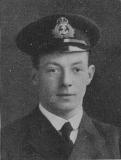
David Oliver Morgan, Private, 10180, Royal Welsh Fusiliers. David was the son of John and Elizabeth Morgan, of Ael y Cryn, Narberth, and enlisted at Pembroke into the 1st Battalion, Royal Welsh Fusiliers. The Battalion were at Malta at the outbreak of war, and were rushed back to England, landing at Southampton on 3 September 1914. Here they were attached to 22 Brigade, 7th Division, and sent to Belgium, landing at Zeebrugge on 7 October 1914, with the intention of aiding the siege of Antwerp. However, Antwerp was falling by the time they arrived, and so the Division moved to Ypres, becoming the first British Troops to garrison the City, taking up positions west of Ypres. The German sweep to the sea came thundering towards Ypres on 19 October 1914 and was stubbornly repulsed by the well trained British Regulars. David was Killed in Action on 20 October 1914, aged 35. His body was never recovered from the battlefields, and so he is remembered on the Ypres (Menin Gate) Memorial, Belgium. David is not commemorated at Narberth.
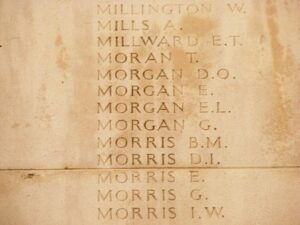
Oliver Nicholas, Private, 10540, Welsh Regiment. Oliver was born in Wiston, the son of Edward and Jane Nicholas. Prior to the war he resided with his brother Albert Nicholas, at St. James Street, Narberth. He enlisted at Llanelli into the 2nd Battalion, Welsh Regiment. At the outbreak of war, the Battalion were at Bordon, as part of 3 Brigade 1st Division. The Division was one of the first to arrive in France, and fought from the opening Battle of Mons, through the epic fighting retreat of the BEF towards the Marne, where they stopped the German Offensive in its tracks. The BEF pushed the Germans back to the Aisne, and fought an action there which set up the positions of the Western Front for the duration of the war. The Division moved north to Ypres in October, where they fought in the successful defence of the City during First Ypres, and so stopped the German move to the sea. After a hard Winter in Flanders, the Division took part in the Battle of Aubers, and then fought at Loos in September 1915. Oliver was Killed in Action during the Battle of Loos on 25 September 1915, aged 25, and is remembered on the Loos Memorial, France.

Frank Esmond Owen, Private, 416, Welsh Regiment. Frank was the son of Mary Jane Owen, of St. James Street, Narberth, and had enlisted at Narberth into the 1/4th Battalion, the Welsh Regiment, which were formed at Carmarthen in August, 1914 as part of South Wales Brigade. On 17 April 1915 they were attached to 159 Brigade, 53rd (Welsh) Division, and in July sailed from Devonport for the Mediterranean. On 9 August 1915 the Division landed at Gallipoli, and this is where Frank was Killed in Action, on 11 August 1915, aged 22. He is remembered on the Helles Memorial, Gallipoli.

Frederick William Owen, Sergeant, 346, Welsh Guards. Frederick was born at Narberth, the son of William and Mary Ann Owen. The family had moved to 38, Ewenny Road, Maesteg prior to the war, and Frederick enlisted there into the Grenadier Guards. After the Welsh Guards were formed by Royal Warrant in 1915, he transferred into the 1st Battalion, Welsh Guards. The Welsh Guards were raised after the Royal Warrant of 26 February 1915. After being formed, they became part of 3 Guards Brigade, Guards Division, which was formed in France in August 1915. Their first taste of battle was at Loos, before being brought south to the Somme in 1916. During the Somme Offensive the Division fought at the Battle of Flers-Courcelette, and at Morval. The Guards followed the German withdrawal to the Hindenburg Line in March 1917 and later fought during Third Ypres, at Pilckem, the Menin Road, Poelcappelle and Passchendaele Village. After the offensive had been called off, the Guards moved south where Frederick was Killed in Action during the Battle of Cambrai, on 1 December 1917, aged 27. He is buried at Gouzeaucourt New British Cemetery, France. Frederick is not commemorated locally.

Thomas James Peregrine, Corporal, 200021, Welsh Regiment. Thomas was the son of William and Jane Peregrine, of High Street, Narberth. He had served before the war with the 4th Welsh, and when war broke out, enlisted into the 14th Battalion, Welsh Regiment (Swansea Pals), which was part of 114 Brigade, 38th (Welsh) Division. The Division had fought on the Western Front since landing in France in December, 1915, fighting on the Somme at Mametz Wood, at Ypres during the Battles of Passchendaele, and through the German Spring Offensive on the Somme. They played a big part in the great advance towards, and eventually through the Hindenburg Line in 1918 which resulted in the Allied Victory. Thomas became ill on 16 December 1918, and was hospitalised, suffering from pneumonia. His condition worsened, and he was found to be suffering from tuberculosis. Thomas died at the Sanatorium, Talgarth, Breconshire on 3 September 1920, aged 34. He is buried at Narberth Cemetery. Photo courtesy of Narberth Museum.


William Peters, Private, 22471, Welsh Regiment. William was probably born at Narberth in 1883. He originally enlisted into the 4th Reserve Battalion, Welsh Regiment. Very little is known of him, except that he was seconded to the Royal Engineers. He died of sickness in Salonika on 29 November 1918. William is buried at Mikra British Cemetery, Kalamaria.
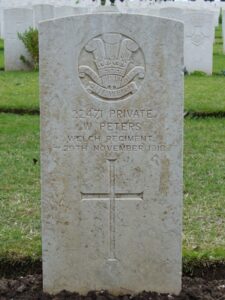
John Evan Phillips, Private, 337, Pembroke Yeomanry. John was born in Robeston Wathen in 1895, the son of Alfred and Anne Phillips. He resided with his Aunt, Martha Howells, at Back Farm, Narberth prior to the war. John enlisted at Narberth into the Pembroke Yeomanry. At the outbreak of war, the Pembroke Yeomanry were mobilised, and sent to Norfolk for coastal defence duties. On 12 August 1915, John was swimming off the Norfolk coast, near the village of Mundesley, when he got into difficulties. One of his friends managed to get to him, and tried to support John in the water until they could be pulled out, but John sadly drowned. He was 21 years old, and his body was brought back home for burial at Robeston Wathen Churchyard.
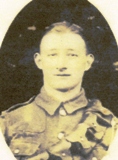

Thomas Aston Phillips, Private, 931114, Canadian Expeditionary Force. Thomas was born at Crinow on 11 July 1875, the son of Benjamin and Phoebe Phillips, of Droslyn. Thomas must have worked at Whitland prior to the war, and emigrated to Canada with his brother William and sister Annie Laurie. Thomas worked in Canada as a Rancher prior to the war. On 4 April 1916 Thomas enlisted at Fernie, British Columbia, into the CEF, and upon arriving in France was posted to the 2nd Battalion, Canadian Mounted Rifles, part of 8 Brigade, 3rd Canadian Division. The Division saw heavy fighting at Mount Sorrel, south of Ypres, during June 1916, then moved to the Somme, and fought at Flers, Thiepval, Le Transloy and the Ancre. They were in the Arras sector in 1917, and took part in the Battle of Vimy Ridge, staying in the area until October 1917 when they moved to Ypres, fighting at Passchendaele village. In 1918 they moved south, taking part in the turning point of the war, the Battle of Amiens, on 8 August 1918 and stayed on the offensive, pushing north-east toward the Scarpe and the Canal Du Nord, where they captured Bourlon Wood. Thomas was Killed in Action during this later battle, on 29 September 1918. He was 43 years old, and is buried at Cantimpre Canadian Cemetery. His brother William Lewis Phillips also fell, as did his cousin William Bowen Stephens. Thomas is not commemorated at Narberth.
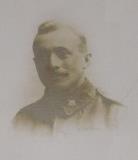

William Lewis Phillips, Private, 931120, Canadian Infantry. William was the brother of Thomas Aston Phillips. He had been born at Droslyn Farm, Crinow, Narberth on 18 September 1879, the tenth child of Benjamin and Phoebe Phillips. William emigrated to Canada in 1911, with his brother Thomas and his sister Annie Laurie and they set up home in Fernie, British Columbia. Annie married sometime after this, and set up home at Walterdale, Edmonton, Alberta. William enlisted at Fernie, British Columbia, on 28 June 1916 into the 54th Battalion (Central Ontario Regiment), which was attached to 11 Brigade, 4th Canadian Division. William embarked for England on 25 January 1917 aboard the SS Grampion, and arrived on 6 February 1917. He moved to France on 17 May 1917 and joined his Battalion north of Arras, where they had just fought in the Battle of Vimy Ridge, where the Canadian Corps managed to capture the almost impregnable German positions on Vimy. In August they fought at the Battle of Hill 70 near Lens, and then moved to Ypres, where they took part in the Second Battle of Passchendaele, where the Canadians captured Passchendaele Village. In 1918 the German Spring Offensive swept through the British lines, first on the Somme, and then in Flanders. The Canadians took part in the Battle of Amiens in August that saw the war turn in the favour of the Allies, where they assaulted German positions at Villers Brettoneux alongside their Australian Colonial allies. They then swept forward, fighting at Damery and Drocourt-Quent, and assaulted the mighty Hindenburg Line, in the Battle of the Canal du Nord. William was killed in action here on 28 September 1918. He was 39 years old, and is buried at Bourlon Wood Cemetery, France. William is not commemorated at Narberth.

Thomas Picton Purser, Private, 6785, Honourable Artillery Company. Thomas was born at Clynderwen on 3 May 1897, the son of William Edward Purser and Mary Anne Purser (nee Johns). His father had died on 2 November 1898, and his mother remarried, moving the family to live with her new husband at Suffolk House, Narberth. Thomas worked for the London City and Midland Bank at Carmarthen prior to the war, and enlisted at Armoury House, London on 20 January 1915 into the 1st Battalion, Honourable Artillery Company. The battalion was in France attached to 8 Brigade, 3rd Division. Thomas joined the battalion in France in November 1916, several months after it had transferred to 190 Brigade, 63rd (Royal Naval) Division, and fought with them during the latter stages of the Somme Offensive at the Ancre. In March 1917 the Division fought in the Arras Offensive, and captured Gavrelle during the Second Battle of the Scarpe. Thomas was wounded during the Battle of the Scarpe, and died of wounds the following day, on 17 April 1917, aged 20. He is buried in Aubigny Communal Cemetery Extension, France.


Thomas H. Rees, Driver, 4405, Royal Field Artillery. Thomas was born in Cork, and had moved to Narberth prior to the war. He enlisted at Haverfordwest into the Royal Field Artillery, and was attached to their ‘D’ Battery, 75th Brigade, which was part of the 16th (Irish) Division, however their stay with the Division turned out to be brief. In August 1915 the Battery transferred to the Guards Division, and fought with them at the Battle of Loos. In June 1916 the Division moved south, taking part in the Battles of Flers-Courcelette and Morval during the Somme Offensive, and after remaining on the Somme over the winter of 1916/17 they followed the German withdrawal to the Hindenburg Line in March 1917. Later in the year, the Guards Division took part in Third Ypres, and fought at the Battle of Pilckem Ridge. Thomas was Killed in Action after the Battle of Pilckem, on 2 September 1917. He is buried at Canada Farm Cemetery, Belgium.
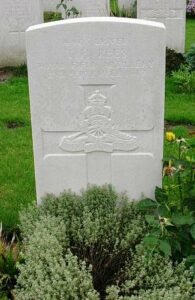
William Reese, Lieutenant, Welsh Regiment. William was born at Newport, Pembrokeshire on 16 September 1884, the youngest son of Abel and Eliza Reese, of Cardiff. He worked at the London City and Midland Bank at Carmarthen before the war, and married the daughter of the manager, Miss Alice Mabel (Lallie) Brockie in 1915. The couple lived above the bank, and also at Brook House, Narberth. William was one of the original officers of the 15th Battalion, Welsh Regiment, known as the Carmarthen Pals Battalion, which was trained at Rhyl, before landing in France in December 1915 as part of 114 Brigade, 38th (Welsh) Division. William served with the battalion over the coming months, and took part in the capture of Mametz Wood in July 1916. He sustained concussion at Mametz, and was evacuated back to Britain, where he took up a post at Kinmel Park after recovery. He died at Rhyl of heart failure just three days after taking up his new post, on 2 February 1917, and was brought home to be buried at Carmarthen Cemetery.


Lewis George Roblin, Second Lieutenant, Northumberland Fusiliers. Lewis was born on 29 December 1898, the son of George Lewis Roblin and Ada Mary Roblin. He was educated at Haileybury, before being commissioned into the Northumberland Fusiliers on 20 December 1917, and was posted to their 1st Battalion, which was part of the 9th Brigade, 3rd Division. The Division had been in France since the Battle of Mons. Lewis would have joined the Battalion around the time of the Battle of Cambrai, and would have spent the winter of 1917/18 in positions near St. Quentin. On 21 March 1918 the Germans launched their last ditch offensive, and swept through the thinly held British lines at St. Quentin and Bapaume, pushing the Allies back over the old Somme Battlefields. The Division were then moved to Northern France, where they were again hit by a fresh German Offensive in Flanders, pushing the Allies back from Estaires, Hazebrouck and to Bethune. Lewis was Killed in Action during these desperate days, on 5 May 1918. He was just 19 years old, and is remembered on the Loos Memorial, France.

John Clement Rowlands, Company Quartermaster Sergeant, 8998, Northamptonshire Regiment. John was the son of John Rowlands, of Narberth, and enlisted at Woolwich prior to 1911 into the 2nd Battalion, Northamptonshire Regiment. At the outbreak of war, the Battalion was in Alexandria. They were sent home, and arrived in England in October 1914, where they were attached to 24 Brigade, 8th Division. The Division moved to the Western Front in November, and saw their first action at Neuve-Chapelle during March and April, 1915. During May they fought at the Battle of Aubers, and then moved south to Loos, where they fought at Bois Grenier in September 1915. John died on 26 November 1915, aged 29, and is buried at Erquinghem-Lys Churchyard Extension, France.

David Salmon, Private, 31204, Royal Welsh Fusiliers. David was born in 1895, the son of John and Sarah Salmon, of Lowlands, Narberth. He enlisted at Carmarthen on 11 May 1915 with his brother Evan into the Royal Field Artillery. The brothers were given consecutive service numbers 98763 and 98764. After several weeks with the 22nd Reserve Battery, both brothers then transferred into the 3rd Battalion, Royal Welsh Fusiliers on 3 June 1915. On 18 December 1915 the brothers arrived in France, joining the 1st Battalion, Royal Welsh Fusiliers, which was attached to 22 Brigade, 7th Division. The Division had served on the Western Front since 7 August 1914, and by early 1916 was stationed on the Somme, at Fricourt. On 2 February 1916 the battalion moved into the front line near Méaulte. Over the coming days, the Germans sporadically shelled their positions, causing several casualties among the battalion. David was killed in action by shellfire on 6 February 1916, aged 21. He is buried at Point 110 New Military Cemetery, Fricourt, France.

Evan Salmon, Private, 31203, Royal Welsh Fusiliers. Evan was born in 1893, the son of John and Sarah Salmon, of Lowlands, Narberth. He enlisted at Carmarthen on 11 May 1915 with his brother David into the Royal Field Artillery. The brothers were given consecutive service numbers 98763 and 98764. After several weeks with the 22nd Reserve Battery, both brothers then transferred into the 3rd Battalion, Royal Welsh Fusiliers on 3 June 1915. On 18 December 1915 the brothers arrived in France, joining the 1st Battalion, Royal Welsh Fusiliers, which was attached to 22 Brigade, 7th Division. The Division had served on the Western Front since 7 August 1914, and by early 1916 was stationed on the Somme, at Fricourt. On 2 February 1916 the battalion moved into the front line near Méaulte. Over the coming days, the Germans sporadically shelled their positions, causing several casualties among the battalion. Evan was mortally wounded alongside his brother on 6 February 1916, and died just a day after his brother, on 7 February 1916, aged 23. He is buried at Corbie Communal Cemetery Extension, France.
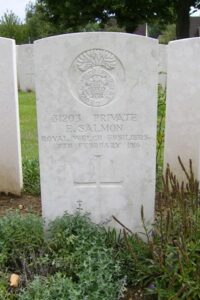
Thomas Stephens, Private, 10525, Welsh Regiment. Thomas was the son of James and Dinah Stephens, of Ashfield Farm, Narberth. He was a regular soldier, and had enlisted at Pembroke Dock into the 2nd Battalion, Welsh Regiment. At the outbreak of war, the Battalion was at Bordon, as part of 3 Brigade 1st Division. The Division was one of the first to arrive in France, and fought from the opening Battle of Mons, through the epic fighting retreat of the BEF towards the Marne, where they stopped the German Offensive in its tracks. The BEF pushed the Germans back to the Aisne, and fought an action there which set up the positions of the Western Front for the duration of the war. The Division mved north to Ypres in October, where they fought in the successful defence of the City during First Ypres, and so stopped the German move to the sea. After a hard Winter in Flanders, the Division took part in the Battle of Aubers, and then fought at Loos in September, 1915. In June, 1916 the Division moved south to the Somme and fought through most of the Battles here from Albert to Morval. In March 1917 they followed up the German withdrawal to the Hindenburg Line, and in the Summer moved to the Flanders Coast in preparation for a planned offensive there. The Offensive was cancelled when the Battles of Third Ypres had ground to a halt in the Flanders mud, and the Division was sent to Ypres, where they fought at the Second Battle for Passchendaele village. Thomas was wounded at Ypres, and brought to the Canadian General Hospital at Etaples, where he sadly Died of Wounds on 15 November 1917, aged 24. Thomas is buried at Etaples Military Cemetery, France. His widow remarried, and resided at 7, Brighton Road, Swansea after the war. Thanks to Mrs Elizabeth Stephens and Mrs Jean Payne, who through the Narberth Museum sent in the photograph of Thomas.


William Bowen Stephens, Private, 282274, Lancashire Fusiliers. William was born on 26 February 1896, the son of Catherine Stephens, of the Parkylan Inn, Llanddewi. William enlisted at Cardiff into the army, and was posted to the 2/7th Battalion, Lancashire Fusiliers, which formed part of 197 Brigade, 66th Division. The Battalion landed at Havre on 28 February 1917, and had moved north with the Division to the Flanders Coast by 26 June 1917. William was killed in action before the move to Flanders, on 18 April 1917, aged 21. His Battalion must have been involved in trench familiarisation in the Loos area before the move to Flanders. William had no known grave, and is commemorated on the Loos Memorial, France. Photo courtesy of Narberth Museum. William is not commemorated at Narberth, but at Llanddewi.


Leonard George Strange, Private, 24096, Grenadier Guards. Leonard was the son of Henry and Margaret Strange, of Hampstead Norris, Newbury, Berks. He worked for the G.W.R. at Narberth prior to the war, and married Martha Jane Hughes there in 1912. Leonard enlisted at Carmarthen into the 2nd Battalion, Grenadier Guards, which was in France attached to 1st Guards Brigade, Guards Division. This was a new formation, and saw its first action at the Battle of Loos in September 1915. The following year saw them move south, and they fought at the Battle of the Somme, at Flers-Courcelette and Morval. After spending the winter of 1916/17 on the Somme, the Guards Division followed the German withdrawal to the Hindenburg Line in March, 1917, and then moved north, where they trained to take part in the Battles of Third Ypres. Here they fought at the Battles of Pilckem, the Menin Road, Poelcappelle and Passchendaele, and were then moved south. Their next attack was as part of the Battle of Cambrai, where Leonard was Killed in Action on 1 December 1917, aged 29. He is remembered on the Cambrai Memorial, Louverval, France. His son, Leonard James Strange was killed during World War Two.
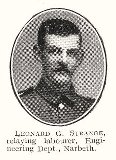

Arthur Evan Ridout Thomas, Corporal, 372, Australian Imperial Force. Arthur was born at Narberth in 1889, the son of Richard and Agnes Thomas. The family later resided at Pembroke Dock, then at Newport House, South Cliff Gardens, Tenby. Prior to the war Arthur had served for three years with the Artists Rifles, and had then emigrated to Australia. Arthur enlisted on 22 February 1915 at Liverpool, NSW into the 18th Battalion, Australian Infantry, which were part of 5 Brigade, 2nd Australian Division. The Battalion left Australia in May 1915 bound for Egypt, and after several months spent training there landed on ANZAC Cove, Gallipoli on 22 August 1915 to reinforce the badly depleted First Division who had been there since landing on 25 April. Just days later, the Battalion took part in the Battle for Hill 60, where Arthur was wounded. He sadly Died of Wounds on 27 August 1915 aged 26. He was buried at sea, and so is remembered on the Lone Pine Memorial, Gallipoli. Arthur is not commemorated at Narberth.
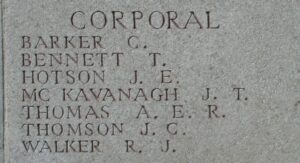
George Lionel Thomas, Private, G/31604, Queen’s Own (Royal West Kent Regiment). George was born at Lampeter Velfrey in 1899, the son of William and Ellen Thomas. The family later resided at 1, Railway Terrace, Narberth. George enlisted at Carmarthen into the Border Regiment. He subsequently transferred into the 7th Battalion, Queen’s Own (Royal West Kent Regiment), which were part of 53 Brigade, 18th (Eastern) Division. On 25 May 1915 the Division landed at Boulogne, and fought in most of the main Battles on the Western Front, fighting on the Somme in 1916, the Battle of Arras, Third Ypres, and the desperate period of the German Spring Offensives of 1918. After the tide of war had turned in favour of the Allies, after the brilliant Australian Victory at Villers Brettoneux on 8 August 1918, the Allies took the initiative and swiftly pushed the Germans back to the Hindenburg Line, and ultimately through it to victory. George was wounded at the first stage of the Hindenburg Line Offensive, during the Battle of Épehy, and Died of Wounds on 29 September 1918, aged only 18. He is buried at Doingt Communal Cemetery Extension, France.

Sidney Vaughan Thomas, Private, 48409, South Wales Borderers. Sidney was born at Ludchurch in 1899, the son of Margaret Thomas. Prior to the war the family had moved to 5, Wells Road Terrace, Narberth. Sidney enlisted at Swansea into the army, and was posted to France late in 1917, joining the 6th Battalion, South Wales Borderers, which had been in France since 25 September 1915 as the Pioneer Battalion to the 25th Division. In July 1916 the Division took part in a big German attack on Vimy Ridge, and after withdrawing for rest and further training moved to the Somme, fighting at the Battle of Albert, Bazentin, Pozieres and the Ancre. In the early part of 1917 the Division moved north to Ploegsteert, and took part in the Battle of Messines in June 1917, before moving to Ypres and fighting at Pilckem Ridge. After Third Ypres, the Division were moved first to Givenchy then to positions near Bullecourt, where they were caught up in the initial assaults of the German Spring Offensive on 21 March 1918. Sidney was Killed in Action on that day, on 21 March 1918, aged only 19, and is remembered on the Arras Memorial. Sidney is not commemorated at Narberth, but at Ludchurch.


William Thomas, Private, 48948, Royal Army Medical Corps. William was born at Cilgerran, the son of David and Margaret Thomas. He spent four years as a pupil teacher at Cilgerran school before going on to Cardigan Intermediate School and then spent a period at Carmarthen Training College. After qualifying as a teacher he was appointed headmaster at Henry’s Moat School in Pembrokeshire. Having worked there for eighteen months he was promoted to headmaster of Llanddewi Velfry School, where he spent five years before enlisting at the end of 1915. He was posted to F Company, Royal Army Medical Corps, which was a training company based at Redan Hill, Aldershot. He married Daisy Victoria Thomas, a fellow teacher, from Narberth on 1 January 1916. Not much is known of William’s time at war, but he returned home to Narberth on 11 March 1916 suffering from ill health, and sadly died at home of sickness on 22 March 1916, aged 27. William is buried at Narberth Cemetery. His widow Daisy married William Griffiths Mathias after the war. Their only son, Flying Officer John Edward Mathias, DFC, was killed on 27 April 1944. William is not commemorated on the Narberth Memorial. The photograph of William and Daisy is courtesy of Michael Cullen.


Gwilym Watkins, Private, 321, Welsh Regiment. Gwilym was the son of Elizabeth Watkins, of Park Terrace, Narberth. He enlisted at Narberth into the 1/4th Battalion, Welsh Regiment, which was the local territorial unit. The battalion was mobilised at Carmarthen in August 1914, as part of South Wales Brigade. On 17 April 1915 it was attached to 159 Brigade, 53rd (Welsh) Division, and in July sailed from Devonport for the Mediterranean. On 9 August 1915 the Division landed at Gallipoli, and was plunged almost immediately into desperate fighting. Gwilym was Killed in Action the following day, on 10 August 1915, aged just 20. He is remembered on the Helles Memorial, Gallipoli.
Thomas Arthur Williams, Private, 372792, London Regiment. Thomas was born at Narberth in 1883, the son of Daniel and Eleanor Williams. Thomas married Frances Emily Bodill in 1915, and the couple resided at Crosslanes, Clynderwen. Thomas enlisted at Clynderwen into the army, and was posted to the 8th Battalion (Post Office Rifles), London Regiment, part of 140 Brigade, 47th Division. The Division was on the Somme in 1916, taking part in the Battle of Le Transloy, when Thomas was Killed in Action on 7 October 1916, aged 33. He is buried in Warlencourt British Cemetery, France. His widow also lost her brother William Henry Bodill during the war.

William Williams, Sergeant, 207204, Royal Engineers. William was the son of John and Ruth Williams, of Ponthenry. The family moved to Mardy prior to 1891, but William had resided at Narberth prior to the war. He returned to Mardy to enlist in the Royal Engineers, where he was posted to the 174th Tunnelling Company, due to his mining experience. On 20 December 1914, ten small mines were blown under the positions held by the Indian Corps at Givenchy, enabling the Germans to capture the ground almost unopposed. As a result of this, the British decided to create their own tunnelling companies, and in February 1915, eight Tunnelling Companies were formed. William served in the 174th Tunneling Company, which moved upon formation to Houplines, and Rue-Du-Bois. They moved to the Somme in July 1915 , taking over French mine-workings at La Boiselle and Carnoy. In October that year they concentrated on workings at Mametz, and when the Somme Offensive had begun, they moved to positions near the Ancre facing Beaumont-Hamel. The German withdrawal to the Hindenburg Line in March 1917 saw the 174th T.C. move to positions east of Bapaume, and this is where William died on 8 September 1917, aged 41. He is buried at Favreuil British Cemetery, France. William is not commemorated locally.

World War Two, 1939-1945
George Glanville Baker, Aircraftman 2nd Class, 1419915, Royal Air Force Volunteer Reserve. George was the son of Stephen and Sarah Jane Baker, of Narberth. Very little is known of him, but served with the RAF, and died in Northumberland on 8 December 1941, possibly as a result of an air raid on Newcastle. George was 19 years old, and is buried at Narberth Cemetery, in Sec. E. Grave 23. His brother Leslie also died.

Leslie Stephen Baker, Gunner, 923450, Royal Artillery. Leslie was the son of Stephen and Sarah Jane Baker, of Narberth. Again, little is known of Leslie, but he served with the Royal Artillery, and died at Narberth on 18 June 1944. He was 25 years old, and is buried at Narberth Cemetery, in Sec. E. Grave 24. His brother George also died.

Thomas Albert Beynon, Marine, PO/X. 119756, Royal Marines. Thomas was born on 28 March 1924, the son of Bertie and Mary Jane Beynon, of Narberth. He had served during the war with the Royal Marines. He was injured during a road traffic accident and died at the Royal Devon and Exeter Hospital of a fractured skull on 21 March 1946. Thomas was 21 years old, and is buried at Narberth Cemetery, Sec. E. Grave 25.
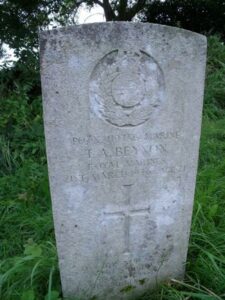
Howell David, Private, 14403119, Middlesex Regiment. Howell served as a wireless operator with the 1st Battalion, Middlesex Regiment. The original battalion was captured by the Japanese at Hong Kong in 1941, and so a new battalion was formed in Britain, becoming part of 15th (Scottish) Division, as a machine-gun unit. The Division landed on the Normandy beaches in June 1944, and took part in the break-out from the beaches, and the destruction of the German forces in Normandy, before the British launched their drive through Northern France into Belgium and Holland. In 1945 the British drove into Germany, and on 8 May 1945, Germany surrendered. Howell died in Germany on 12 May 1945. He was 21 years old, and is buried at Hamburg War Cemetery, Germany, in Grave Ref. 3A. A. 1.
William James Hill, Sergeant, 1417968, Royal Air Force Volunteer Reserve. William was the son of George and Mary Sophia Hill, of Castle View, Narberth. He married Heloise Patricia Shenton, of Kidderminster in 1942 and the couple then lived at Brixton, London. He worked in London as a schoolmaster prior to enlisting into the Royal Air Force, where he was posted to 98 Squadron. The squadron was a bomber squadron, equipped with the Mitchell for the last two years of the war, and had taken part in many raids over Germany and Holland, before forming part of the occupation force in Germany after VE Day, when the squadron reverted to Mosquito’s. William died at Grove Park Hospital, London on 22 December 1946, although the cause is not known. He was 33 years old, and is buried at Brookwood Military Cemetery, England, in Grave Ref. 21. E. 15.

Henry Brynmor John, Paymaster Commander (S), Royal Navy. Henry was the son of Jonah and Mary John and was born in 1897 in High Street, Narberth. Henry had married Elizabeth Dorothy Williams, who was the daughter of Mr. & Mrs. John F. Williams of Laugharne. Harry was educated at Narberth School, and during 1914, at the age of 17, he entered into St. George’s College in London to pursue a Naval Career. At the age of 18, Harry was serving in the Royal Navy-probably aboard H.M.S. Juno, where he assisted with the rescue of survivors from the torpedoed passenger ship ‘Lusitania’, which had been sunk by a German submarine off the Irish coast with great loss of life. By 1920, Harry had been awarded the Order of the Nile, whilst serving at the Royal Naval base at Port Said. And had reached the rank of Paymaster-Lieutenant. Later that year Harry was awarded the MBE and was invested by King George V at Buckingham Palace. By the age of 38, Harry had risen to the rank of Paymaster Commander. Harry’s first posting after the Great War was aboard the cruiser HMS Frobisher. On 14 November 1930, he was posted to Bermuda (HMS Flora). Harry spent a year aboard the battleship HMS Rodney, until July 1935, and then transferred to the cruiser HMS Exeter where he saw active service during the famous ‘Sinking of the Graf Spee’ off the River Plate in South America. He served aboard the HMS Exeter until August 1939 and from 15 November 1941, Harry served aboard the Battleship HMS Resolution, as Squadron Accountant, 3rd Battle Squadron. On 29 December 1943, Harry was transferred to the navigation school at Portsmouth (HMS Dryad). He was promoted to Commander in the Royal Navy, and served on the Combined Operations staff under Lord Mountbatten, which planned the D-Day landings. Harry’s last posting was at HMS President-a Royal Naval Gunnery School in London. It was whilst serving there that Harry and his wife decided to visit Plymouth en-route to a trip home to visit family in Narberth and Laugharne. Whilst in Plymouth, Harry took ill and was taken into St. George’s Hospital in London. He died three weeks later of heart failure, aged 49, on 26 August 1946 and was cremated in the Golders Green Crematorium, Middlesex. He had been a Burgess of Laugharne and also a Vice-President of the ‘Laugharne Sports and Attractions.’ Henry left behind his wife Elizabeth, his brother, Lieutenant-Commander Roy John, and two sisters, Mrs J. Evans Williams of Llanelli and Miss Elvie John of Narberth. Many thanks to Helen John for the photograph.

John Edward Mathias, DFC, Flying Officer (Pilot), 162961, Royal Air Force Volunteer Reserve. John was the son of William Griffiths Mathias and Daisy Victoria Mathias, of Narberth. He trained as a Pilot, and served with 305 (Polish) Squadron, an elite unit, which was armed with the twin-engined De Havilland Mosquito. He was awarded the Distinguished Flying Cross in September 1943, but was sadly killed on 27 April 1944 during a training exercise. John was 23 years old, and is buried at Narberth Church Cemetery, N.W. Section, Row 3, Grave 29. Many thanks to Les Nixon for the photographs, and the copies of John’s details from the Narberth Museum. His mother Daisy had lost her first husband during the Great War.


Stanley Lewis Morgan, Leading Stoker, D/K65937, Royal Navy. Stanley was born on 10 December 1906, the son of William and Elizabeth Morgan, of Narberth. He married Dorothy Sarah Thomas, of Marros, in 1929, not long after he had enlisted into the Royal Navy. Stanley had a variety of postings prior to being posted aboard HMS Exeter in March 1941. Exeter was a York Class Heavy Cruiser, which formed part of the South American Division early in the war, taking part in the Battle of the River Plate. During the Battle, she lost 61 crew killed, and a further 23 wounded. After withdrawing to Port Stanley for temporary repairs, Exeter made for Devonport, where she was refitted. She returned to service in 1941, taking part in the Bismark episode before being posted to the ABDACOM Naval force in the Pacific, due to Japans entry into the war. The brief of ABDACOM was to protect the Dutch East Indies (now Indonesia), and it was here on 27 February, 1942 that the Exeter took part in the Battle of the Java Sea, where she suffered a direct hit in the boiler room. Whilst attempting to withdraw to Surabaya, the Exeter was attacked again, finally being sunk by a torpedo on 1 March, 1942. Stanley died on 27 February, 1942, and is buried at Jakarta War Cemetery, in Grave 5.K.5. He was 35 years old. It is unknown whether he died of wounds suffered during the battle, or was already in Jakarta, suffering from illness.

Aneuryn Hugh Nicholas, Bombardier, 923449, Royal Artillery. Aneuryn was the son of Albert and Margaret Annie Nicholas, of Narberth, and served with 102 (The Pembroke Yeomanry) Field Regiment, Royal Artillery. The first line 102nd Field Regiment, formed from the two Pembrokeshire Batteries, landed at Algiers in February 1943 with one of the first two self propelled 25 pounder batteries to see action. Aneuryn was killed soon after, on 3 March 1943, during the fall of Tunis. He was 21 years old, and is buried at Beja War Cemetery, Tunisia.
William Charles Phillips, Lance Serjeant, 4180312, Royal Corps of Signals. William was the son of Sidney John and Mary Phillips, of Narberth. He lived with his wife Gertrude Mabel Phillips, at Llandefaelog, Powys prior to the war. William served with the Royal Corps of Signals. He died on active service in Yorkshire on 28 October 1942, aged 42, and is buried in Llandefaelog-Fach (St. Maelog) Churchyard, Powys. William does not appear to be commemorated locally.
Graham Arthur Steadman, AFC, Flight Lieutenant (Pilot), 169596, Royal Air Force Volunteer Reserve. Graham was the son of Arthur Edward and Dorothy Daisy Steadman, and the husband of Sheila Margaret Steadman, of Finchley, London. He was a pilot with the Royal Air Force, and had been awarded the Air Force Cross on 6 June 1943. He was then based at Aden, and it was there that he died on 30 June 1945. Graham was 24 years old, and is buried at Maala Cemetery, Yemen, in Grave Ref. H. 120.
Samuel Idwal Tucker, Trooper, 7916945, Royal Armoured Corps. Samuel was the son of James John and Sophia Tucker, of Narberth, and served with the 44th Royal Tank Regiment, Royal Armoured Corps. The Battalion sailed from Greenock on 23 April 1941 aboard SS Sobiesky, the escorted by HMS Repulse. She anchored off Freetown, Sierra Leone on 5 May, then at Durban, South Africa, and up the Red Sea, arriving at Suez on 13 June 1941. The battalion then moved by train to Sidi Bishr camp, east of Alexandria, where it formed part of the 4th Armoured Brigade of the 7th Armoured Division. On 1 July1941, the battalion moved to Abu Madi and became part of the 1st Army Tank Brigade, and advanced on Bir Ramadan area in September 1941. Seeing its first action, as part of Operation ‘Crusader’, which started on 15 November with the advance into Libya, the battalion crossed the frontier on 21 November, attacking the fortresses of Sidi and Nuovo Omar. Samuel was killed on the following day, 22 November 1941. He was 26 years old, and is buried at Halfaya Sollum War Cemetery, Egypt.